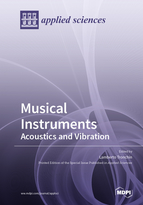Musical Instruments: Acoustics and Vibration
A special issue of Applied Sciences (ISSN 2076-3417). This special issue belongs to the section "Acoustics and Vibrations".
Deadline for manuscript submissions: closed (31 December 2019) | Viewed by 38008
Special Issue Editor
Interests: acoustics; room acoustics; musical acoustics; emulation of nonlinear acoustic systems; 3D auralisation; multiple arrays in 3D acoustic measurements; noise barriers
Special Issues, Collections and Topics in MDPI journals
Special Issue Information
Dear Colleagues,
The sound and vibration of musical instruments has gathered great attention among scientists, musicians, and artists since the early knowledge of physics, dating back 2500 years. Several important international institutions and museums are collecting musical instruments and studying their history and origins. However, only a small part of the research deals with the physical characteristics of musical instruments, and an even smaller part deals with the sound emitted from them. This Special Issue intends to give an opportunity to collect several studies about the acoustics and vibration of musical instruments, both considering classical and ethnic MIs, ranging from measurements to emulations, including physical modelling and virtual musical instruments. This SI is intended for scientists, researchers, and curators that intend to propose a high level of unpublished research, both with theoretical and experimental approaches.
Dr. Lamberto Tronchin
Guest Editor
Manuscript Submission Information
Manuscripts should be submitted online at www.mdpi.com by registering and logging in to this website. Once you are registered, click here to go to the submission form. Manuscripts can be submitted until the deadline. All submissions that pass pre-check are peer-reviewed. Accepted papers will be published continuously in the journal (as soon as accepted) and will be listed together on the special issue website. Research articles, review articles as well as short communications are invited. For planned papers, a title and short abstract (about 100 words) can be sent to the Editorial Office for announcement on this website.
Submitted manuscripts should not have been published previously, nor be under consideration for publication elsewhere (except conference proceedings papers). All manuscripts are thoroughly refereed through a single-blind peer-review process. A guide for authors and other relevant information for submission of manuscripts is available on the Instructions for Authors page. Applied Sciences is an international peer-reviewed open access semimonthly journal published by MDPI.
Please visit the Instructions for Authors page before submitting a manuscript. The Article Processing Charge (APC) for publication in this open access journal is 2400 CHF (Swiss Francs). Submitted papers should be well formatted and use good English. Authors may use MDPI's English editing service prior to publication or during author revisions.
Keywords
- musical instruments
- modal analysis
- mobility and admittance
- sound radiation
- physical modelling






